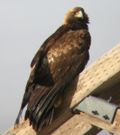Alaska Fish & Wildlife News
December 2004
Western Alaska Moose:
Really Big Deer

I sat in the small cabin with my good friend and coworker Joe Chythlook, listening as he explained nuances of his native Yup'ik language. I learned that “tuntu” is deer and “tuntuvak” is really big deer or what we gu-suk refer to as moose. That was what I was after, a really big deer.
It all started ten years ago when I first met Joe. Joe was just a really neat guy - an Eskimo, a bush pilot, a Bristol Bay fisherman, a Christian and a really interesting fellow with great stories about ...
Alaska Moose ArticleContinued
Alaska’s Most Powerful Bird of Prey

Golden eagles are formidable predators in Alaska. Bigger and more aggressive than bald eagles, golden eagles prey on young Dall sheep and caribou - and can take even larger prey.
“They're built for killing,” said Fairbanks wildlife biologist Jack Whitman, who studied golden eagles in Idaho. “Comparing their physical strength and food habits to bald eagles, the golden eagle is an aggressive, successful predator, and the bald eagle is a really good scavenger. How often do you see a golden ...
Golden Eagles ArticleContinued
Young Golden Eagles Have Tough Time

Alaska is home to the highest density of nesting golden eagles in North America, in Denali National Park. The big raptors are found throughout the state, but nesting pairs favor mountainous territory like the Alaska Range.
National Park Service biologist Carol McIntyre has been studying golden eagles in Denali for 17 years. She's documenting reproductive success, and over the years she's equipped 48 eagles with transmitters to study their seasonal migrations. About 70 to 75 pairs of eagles ...
Migrations ArticleContinued
Bridging Cultural Differences

“Personally, I like to eat close to the land, and also enjoy learning about and trying new things. I just got a recipe for pudding made from chum eggs and high bush cranberries," she said. "When you mix the two together you actually get a custard. It's surprisingly very good.” Nancy Ratner
Nancy Ratner spent her childhood in a Chicago suburb, but for 26 years she has worked in bush Alaska where she feels at home in Alaska's remote settlements. Her enthusiasm for subsistence ...
Subsistence ArticleContinued
Dead Salmon Bring Life to Rivers

This summer was rife with spawned-out salmon rotting on river banks in the hot sun. The smell can be off-putting, but the value of those decomposing salmon to the food web is striking. Coowe Walker, a watershed specialist with the Kachemak Bay Research Reserve, is looking at how nutrients from returning salmon support stream food webs, and especially how they contribute to the development of young salmon.
Walker and other researchers are using the North Fork and Chakok branches of the ...
Salmon ArticleContinued
Speaking Out on Fish and Wildlife Issues

Kathy Hansen is an everyday kind of gal with an above-average sense of responsibility. Hansen provides “from-the-field” recommendations to the Alaska Boards of Fisheries and Game. Hansen has been the chairwoman of the Juneau-Douglas Advisory Committee for two years and has served on the committee since 1999.
Advisory committees (AC) are grassroot volunteer groups that meet to discuss fish, wildlife and habitat issues, and receive community input. Public involvement is critical to the ...
Speaking Out ArticleContinued
Helping Anglers Access to Alaska’s Abundant Waters

Fishing from the shore is a rewarding activity for many Alaskans. For others, hopping in a skiff and feeling the wind in their hair and the chop under foot adds to the enjoyment. Others want to see and experience sea life that is only available by boat - or simply get out on the water and get away from it all.
The Alaska Department of Fish and Game does more than manage fish and wildlife, it also helps Alaskans and visitors access wildlife and habitat.
The department's Division ...
Editorial ArticleContinued
